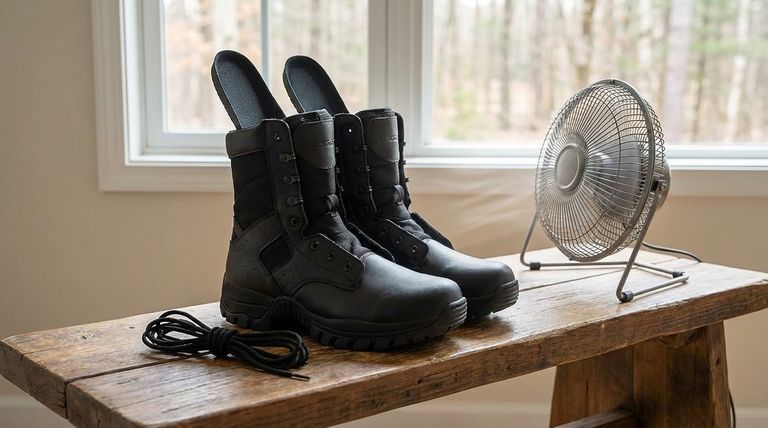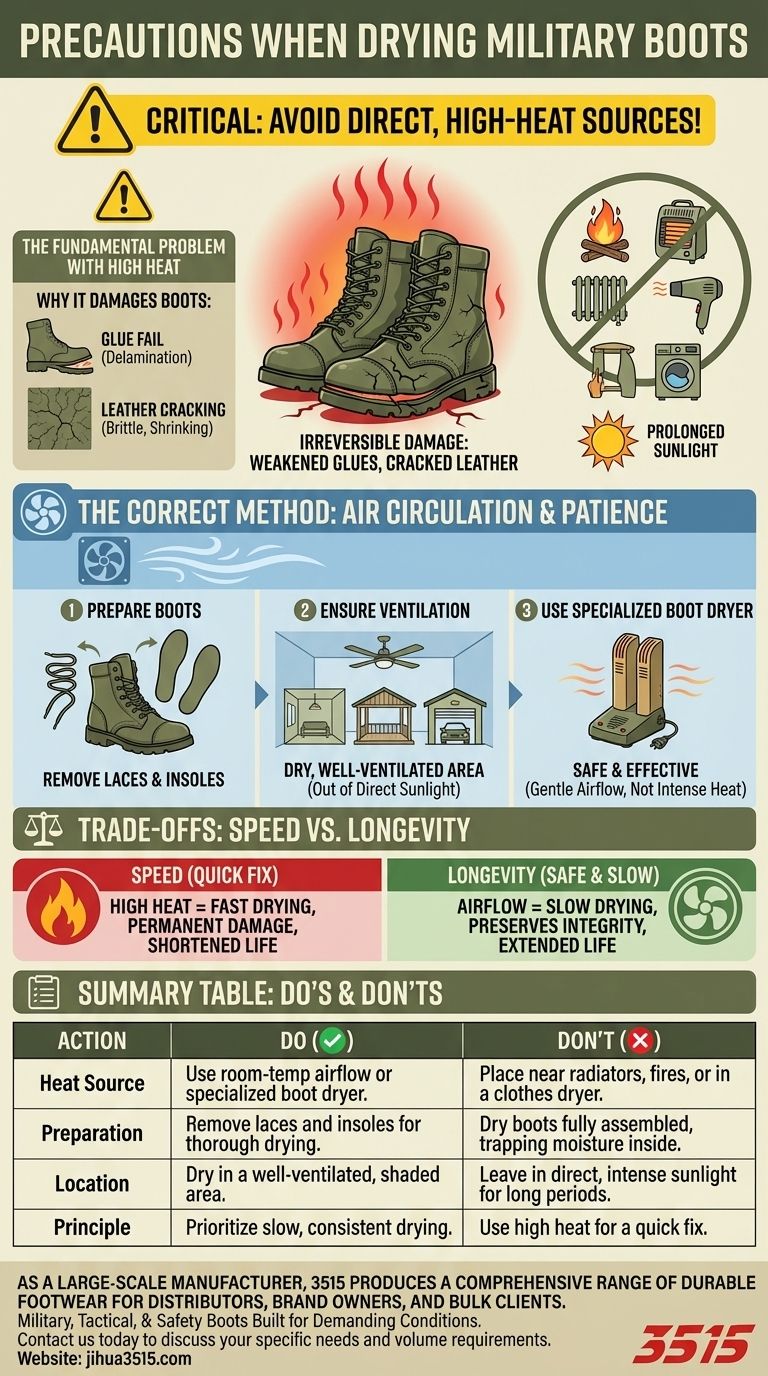The most critical precaution when drying military boots is to avoid direct, high-heat sources at all costs. Methods like placing them near a heater, in a clothes dryer, or using a hairdryer can seem like a quick fix but will irreversibly damage the materials. The glues that bond the sole will weaken, and the leather can dry out, crack, and lose its supportive structure.
The core principle of safe boot drying is to prioritize slow, consistent airflow over intense heat. This method preserves the boot's structural integrity and materials, ensuring longevity and performance, even if it takes longer.

The Fundamental Problem with High Heat
Intense, direct heat is the primary enemy of modern military footwear. Understanding why it's so destructive is the key to proper maintenance and extending the life of your essential gear.
Why High Heat Damages Your Boots
Direct heat attacks the boot's core components. It can cause the specialized glues and adhesives used to bond the sole to the upper to loosen or fail, leading to delamination. For leather boots, it strips away natural oils, causing the material to become brittle, shrink, and eventually crack.
Common Heat Sources to Avoid
Always keep your boots away from these common sources of damaging heat:
- Campfires or portable heaters
- Radiators and heating vents
- Hair dryers or heat guns
- Clothes dryers
- Direct, intense sunlight for prolonged periods
The Correct Drying Method: Air Circulation
The safest and most effective way to dry boots involves patience and maximizing airflow. This allows moisture to evaporate naturally without stressing the boot's materials.
Step 1: Prepare the Boots
Before you begin drying, always remove the laces and insoles. This opens up the boot's interior, allowing trapped moisture deep inside to escape and ensuring every part dries thoroughly.
Step 2: Ensure Proper Ventilation
Place the boots in a dry, well-ventilated area that is out of direct sunlight. An open room with a fan, a covered porch, or a garage are all excellent locations. The goal is to have consistent air moving over and through the boots.
Step 3: Consider a Specialized Boot Dryer
A specialized boot dryer is a safe and effective tool. These devices use gently warmed or room-temperature air circulated by a fan, which is ideal. They accelerate drying without resorting to damaging high temperatures.
Understanding the Trade-offs: Speed vs. Longevity
In situations where you need dry boots quickly, it's tempting to use a faster, high-heat method. This is a critical mistake that sacrifices the long-term health of your boots for short-term convenience.
The Temptation of a Quick Fix
Using a hairdryer or setting boots by a fire can dry them in a fraction of the time, but this speed comes at a high cost. The damage from just one improper drying session can permanently weaken the boot.
The Long-Term Cost of Improper Drying
Each exposure to high heat compromises the boot's construction. This cumulative damage leads to cracked leather, separating soles, and a shortened service life. A well-maintained pair of boots can last for years; a heat-abused pair may fail in a matter of months.
Making the Right Choice for Your Situation
Your approach to drying should match the level of moisture in the boots.
- If your boots are damp from sweat after a day's use: Simply remove the insoles and leave them in a well-ventilated room overnight.
- If your boots are completely soaked: Remove laces and insoles, and ideally, place them on a low-heat boot dryer or in front of a room fan for 8-12 hours.
- If you need to dry them in the field: Stuff them with dry, absorbent material (like a spare t-shirt or paper towels, if available) and place them in a sheltered, breezy spot away from the campfire.
Properly caring for your boots ensures they will be ready to perform when you need them most.
Summary Table:
| Action | Do | Don't |
|---|---|---|
| Heat Source | Use room-temperature airflow or a specialized boot dryer. | Place near radiators, fires, or in a clothes dryer. |
| Preparation | Remove laces and insoles for thorough drying. | Dry boots fully assembled, trapping moisture inside. |
| Location | Dry in a well-ventilated, shaded area. | Leave in direct, intense sunlight for long periods. |
| Principle | Prioritize slow, consistent drying. | Use high heat for a quick fix. |
As a large-scale manufacturer, 3515 produces a comprehensive range of durable footwear for distributors, brand owners, and bulk clients. Our production capabilities encompass all types of military, tactical, and safety boots built to withstand demanding conditions. Let us help you equip your team with reliable, long-lasting footwear. Contact our experts today to discuss your specific needs and volume requirements.
Visual Guide

Related Products
- Durable Leather Tactical Boots Wholesale & Custom Manufacturing for Brands
- Durable Leather High-Ankle Tactical Boots for Wholesale & Custom Manufacturing
- Wholesale Waterproof Tactical Boots Custom Suede & High-Traction Soles
- High-Traction Suede Tactical Boots Wholesale & Custom Manufacturing
- Wholesale Lightweight Tactical Boots with Dial Closure OEM & Bulk Orders
People Also Ask
- What does the upper part of a tactical boot cover? Your Guide to Protection, Fit, and Performance
- How do tactical boots and regular shoes differ in cushioning and padding? Unlock the Key to Performance & Protection
- What are the primary uses of tactical boots? Essential Footwear for Demanding Professionals
- What is the function of the insole in tactical boots? A Guide to Foot Support & Performance
- What are the steps to clean full-grain leather military boots? Preserve & Protect Your Gear



















